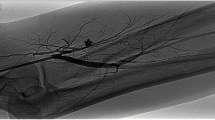Abstract
Background
Peripheral neuropathy is a common complication of chronic renal failure (CRF). Superimposed neuropathies may complicate arteriovenous fistulas (AVF) construction. The aim of this study was to evaluate the effect of AVF construction on nerve conduction.
Materials and methods
Twenty-six patients were included in this prospective case–control study. All patients underwent clinical and electrophysiologic evaluations 1 week before and 3 months after AVF placement. A side-to-side fistula was set up for all patients, and the radial, ulnar, and median nerves were studied. Patient’s non-fistula hand served as a control.
Results
No significant changes were observed on neurological examination of the upper limbs following AVF construction. In the case of motor nerves, the AVF hand had decreased amplitude of distal and proximal segments of the radial nerve (P = 0.025 and P = 0.042), proximal segment of the median nerve (P = 0.025), and increased distal latency of the ulnar nerve (P = 0.027). No significant changes were observed for sensory parameters.
Conclusions
This study showed that all three nerves of the upper extremity can be affected by hemodialysis vascular access construction in patients with CRF, and the motor radial nerve was the most affected nerve.
Similar content being viewed by others
References
Brouns R, De Deyn PP (2004) Neurological complications in renal failure: a review. Clin Neurol Neurosurg 107(1):1–16
Krishnan AV, Kiernan MC (2007) Uremic neuropathy: clinical features and new pathophysiological insights. Muscle Nerve 35(3):273–290
Bosch EP, Smith BE (2004) Disorders of peripheral nerves. In: Bradley WG, Daroff RB, Fenichel G et al (eds) Neurology in clinical practice, 4th edn. Butterworth Heinemann, Philadelphia
Tilki HE, Akpolat T, Coskun M et al (2009) Clinical and electrophysiologic findings in dialysis patients. J Electromyogr Kinesiol 19(3):500–508
Rogers NM, Lawton PD (2007) Ischaemic monomelic neuropathy in a non-diabetic patient following creation of an upper limb arteriovenous fistula. Nephrol Dial Transplant 22(3):933–935
Ropper AH, Brown RH (2005) Adams and victor’s principles of neurology, 8th edn. McGraw-Hill, New York
Bickley LS, Szilagyi PG (eds) (2005) Bates’ guide to physical examination and history taking, 9th edn. Lippincott Williams and Wilkins, Philadelphia
Bessias N, Paraskevas KI, Tziviskou E et al (2008) Vascular access in elderly patients with end-stage renal disease. Int Urol Nephrol 40(4):1133–1142
NFK-K/DOQI Clinical Practice Guidelines for Vascular Access: update 2000 (2001) Am J Kidney Dis 37:S137–S181
Rayner HC, Pisoni RL, Gillespie BW et al (2003) Creation, cannulation and survival of arteriovenous fistulae: data from the dialysis outcomes and practice patterns study. Kidney Int 63(1):323–330
Stolic RV, Trajkovic GZ, Peric VM et al (2008) The influence of atherosclerosis and plasma D-dimer concentration in patients with a functioning arteriovenous fistula for maintenance hemodialysis. Int Urol Nephrol 40(2):503–508
Acarturk G, Albayrak R, Melek M et al (2008) The relationship between arteriovenous fistula blood flow rate and pulmonary artery pressure in hemodialysis patients. Int Urol Nephrol 40(2):509–513
Lin G, Kais H, Halpern Z et al (1997) Pulse oxymetry evaluation of oxygen saturation in the upper extremity with an arteriovenous fistula before and during hemodialysis. Am J Kidney Dis 29(2):230–232
Castaigne P, Cathala HP, Beaussart-Boulengé L et al (1972) Effect of ischaemia on peripheral nerve function in patients with chronic renal failure undergoing dialysis treatment. J Neurol Neurosurg Psychiatry 35(5):631–637
Sladky JT, Tschoepe RL, Greenberg JH et al (1991) Peripheral neuropathy after chronic endoneurial ischemia. Ann Neurol 29(3):272–278
Oh SJ (1993) Clinical electromyography: nerve conduction studies, 2nd edn. Lippincott Williams and Wilkins, Baltimore
Holtmann B, Anderson CB (1977) Carpal tunnel syndrome following vascular shunts for hemodialysis. Arch Surg 112(1):65–66
Harding AE, Le Fanu J (1977) Carpal tunnel syndrome related to antebrachial Cimino-Brescia fistula. J Neurol Neurosurg Psychiatry 40(5):511–513
Martinelli P, Baruzzi A, Montagna P et al (1981) Carpal tunnel syndrome in a patient with a Cimino-Brescia fistula. Eur Neurol 20(6):478–480
Poulenas I, Spertini F, Wauters JP (1983) The carpal tunnel syndrome in chronic dialysis patients, it is a late complication of the arterio-venous fistula? Ann Chir Main 2(3):244–249
Shin J, Nishioka M, Shinko S et al (2008) Carpal tunnel syndrome and plasma beta2-microglobulin concentration in hemodialysis patients. Ther Apher Dial 12(1):62–66
Klein C, Halevy A, Gandelman-Marton R et al (1996) Nerve conduction abnormalities in the arms of patients with arteriovenous fistula. Ren Fail 18(1):85–89
Knezevic W, Mastaglia FL (1984) Neuropathy associated with Brescia-Cimino arteriovenous fistulas. Arch Neurol 41(11):1184–1186
Spertini F, Wauters JP, Poulenas I (1984) Carpal tunnel syndrome: a frequent, invalidating, long-term complication of chronic hemodialysis. Clin Nephrol 21(2):98–101
Zampollo A, Costanzo R, Locatelli F (1985) Arteriovenous fistula and nerve conduction velocity in patients on hemodialysis: statistical and electrographic findings. Ital J Neurol Sci 6(3):323–327
Bussell JA, Abbott JA, Lim RC (1971) A radial steal syndrome with arteriovenous fistula for hemodialysis. Studies in seven patients. Ann Intern Med 75(3):387–394
Tordoir JH, Dammers R, Van der Sande FM (2004) Upper extremity ischemia and hemodialysis vascular access. Eur J Vasc Endovasc Surg 27(1):1–5
Acknowledgments
Disclosure
The authors have no financial interests to disclose in relation to the content of this article.
Author information
Authors and Affiliations
Corresponding author
Rights and permissions
About this article
Cite this article
Talebi, M., Salari, B., Ghannadan, H. et al. Nerve conduction changes following arteriovenous fistula construction in hemodialysis patients. Int Urol Nephrol 43, 849–853 (2011). https://doi.org/10.1007/s11255-010-9740-9
Received:
Accepted:
Published:
Issue Date:
DOI: https://doi.org/10.1007/s11255-010-9740-9




